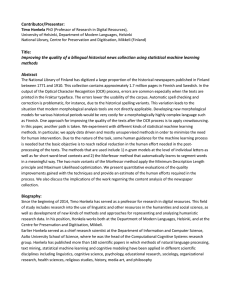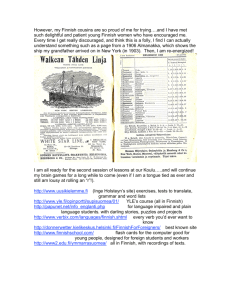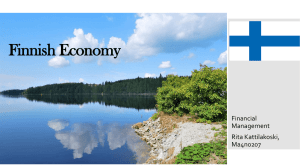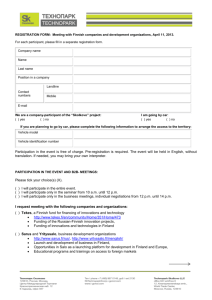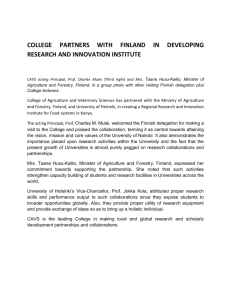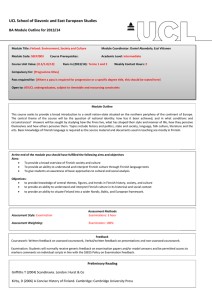Helsinki as a multilingual language community Pirkko Nuolijärvi
advertisement
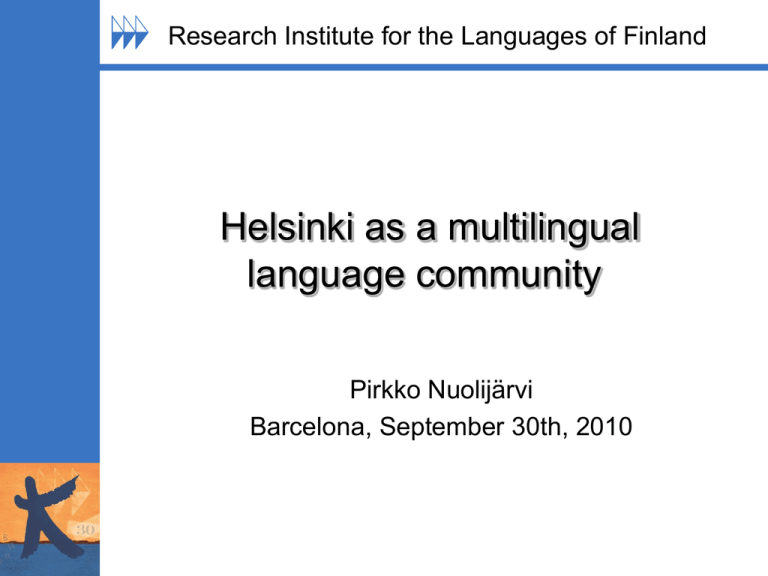
Research Institute for the Languages of Finland Helsinki as a multilingual language community Pirkko Nuolijärvi Barcelona, September 30th, 2010 Contents • demographic situation in Finland and language rights • immigration and the linguistic repertoire of Helsinki • the multilingual image of the city • multilingual public services • languages at school and language use in universities • Helsinki from the sociolinguistic point of view • similarities and differences with other urban areas • concluding remarks Four main stages of Finland’s political history • a period of Scandinavian hegemony and union with Sweden from the Middle Ages down to 1809 • a period as an autonomous grand duchy of Russia 1809–1917 • a period as an independent republic 1917– • a period as a member state of the European Union 1995– Finnish and Swedish today • the official languages in the European Union • the national languages in Finland • Finnish as the majority language in Finland used by 4.8 million people • Swedish as the second language in Finland used by 300 000 people as a mother tongue • Swedish the majority language and Finnish the minority language in Sweden (in northern and centre municipalities Finnish and Swedish in Finland 1.1.2009 Finnish Swedish Source: Statistics Finland 4 828 747 91,5 % of the population 289 609 5,5 % Constitution 2000 Section 17. Right to one’s language and culture. The national languages of Finland are Finnish and Swedish. The right of everyone to use his own language, either Finnish or Swedish, before court of laws and other authority, and to receive documents in that language, shall be guaranteed by an Act. The public authorities shall provide for the educational, cultural and societal needs of the Finnish-speaking and Swedish-speaking populations of the country on an equal basis. Language Act 2004 • Unilingual or bilingual state authorities in Finnish and Swedish • Unilingual municipalities in Finnish (292) or Swedish (19) or bilingual municipalities in Finnish and Swedish (18,13) (Totally, 1,5 million inhabitants live in bilingual municipalities.) • The right of the individual to use his or her own language in authorities • Flexible service in both languages • Information in both Finnish and Swedish • Authorities to ensure language rights Monolingual and bilingual municipalities Population in Helsinki Total population (1.1.2010) 583 350 (in the Helsinki region 1.3 million people) Men 46.9 % Women 53.1 % Finnish-speaking 83.7 % Swedish-speaking 6.1 % Other languages 10.2 % Foreign citizens 7.2 % Table 2. The whole population by mother tongue in Helsinki at the turn of year 2008/2009 (Statistics Finland 2009). Mother tongue Whole population Finnish Swedish Other languages total Russian Estonian Somali English Arabic Chinese Kurdish Spanish German French Turkish Vietnamese Other language Persons 576 632 486 218 35 124 56 321 12 470 6 217 5 792 3 798 2 534 1 968 1 562 1 558 1 366 1 238 1 177 1 031 15 610 % 84,3 6,1 9,6 2,2 1,1 1,0 0,7 0,4 0,3 0,3 0,3 0,2 0,2 0,2 0,2 2,7 The image of Helsinki • highly educated people • state administration and public sphere visible • cultural national institutions • activities and hobbies • names of buildings and gates Signs and information Mannerheimintie Mannerheimvägen Kaupunginteatteri Stadsteatern Helsingin rautatieasema Helsingfors järnvägsstation Languages at school (1) Separate Finnish and Swedish schools in every bilingual environment and also in many unilingual towns Instruction of native language (other than Finnish, Swedish or Sámi): 2 h / week Languages at school (2) Helsinki comprehensive school: • Instruction in 40 mother tongues (Russian, Somali, Estonian, Arabic, Vietnamese etc.) • 12 % of pupils learn Finnish as a second language • Bilingual education in some schools: in Russian and in Finnish in Estonian and in Finnish in Somali and in Finnish in Arabic and in Finnish in Chinese and in Finnish • Language immersion in Swedish for Finnish-speaking pupils Languages at school (3) A-languages of the secondary school graduates in 2006: 99,3 % English as an A-language 8,9 % German 7,7 % Swedish 6,3 % Finnish 2,3 % French 0,7 % Russian Integration Services in Helsinki include • guidance and advice in everyday routines and social functions with information about language courses and other training. • acquiring information about social security, assessing the client’s economic situation and when necessary granting a living/integration allowance • appeals integration-related discussions and meetings on a personal or family level with social workers and • guides a possibility for refugee families to get psychological services to support children’s integration acquiring information about matters concerning family reunion Services are applied at the Immigration Unit by making an appointment personally or by phone. The service is produced by the Immigration Unit in cooperation with other authorities if necessary. The services are free of charge. Language strategies: University of Helsinki “The University of Helsinki maintains, encourages and supports an active bilingual environment. Because the University is the academic flagship of an officially bilingual society, bilingualism within the university community must be both omnipresent and functional. Teaching and learning should meet the requirements set by Finland’s bilingual society and by legislation. The internationalisation of teaching and research requires ongoing activity in foreign languages. Arranging teaching in English supports the educational targets set by the University without undermining the position of Finland’s national languages.” Concluding remarks It is needed • language strategies and good practical solutions to maintain and develope Finnish and Swedish in universities and in scientific work • special support for the minority language Swedish in Helsinki • more support for the minority languages in the comprehensive school • more support for courses of Finnish and Swedish as a second language • more social and health service in minority languages (e.g. Russianspeaking doctors, interpreters in various languages)

